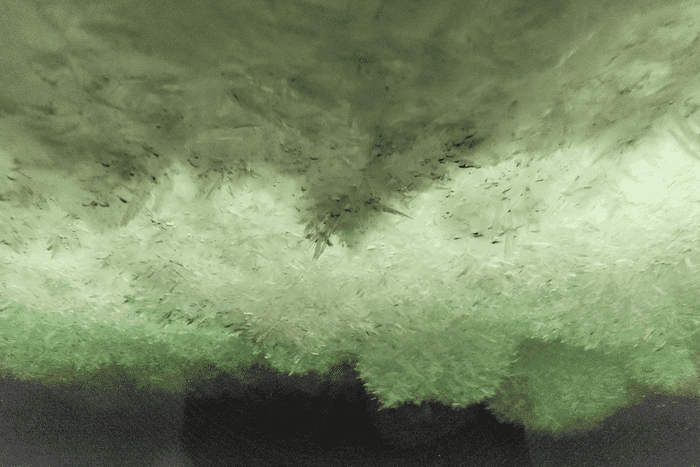Predicting Alien Life: Discovering New Non-Xenomorph Species On Earth

Table of Contents
Extremophiles: Earth's Alien Inhabitants
Defining Extremophiles:
Extremophiles are organisms thriving in "extreme environments" – conditions previously thought to be inhospitable to life. These extremophile environments push the boundaries of what we consider habitable, challenging our assumptions about the requirements for life. Extremophile bacteria and other extremophiles exhibit remarkable adaptations, showcasing the diversity and resilience of life on Earth. They are unusual life forms that provide invaluable insights into the potential for life on other planets.
- Examples of extremophiles: Thermophiles (heat-loving), halophiles (salt-loving), acidophiles (acid-loving), psychrophiles (cold-loving), and piezophiles (pressure-loving).
- Locations: Deep-sea hydrothermal vents, hot springs, highly acidic or saline lakes, subglacial lakes, and even within rocks deep underground.
- Unique Metabolic Processes: Many extremophiles utilize unique metabolic pathways, such as chemosynthesis (deriving energy from chemical reactions) instead of photosynthesis, to survive in their resource-scarce environments.
The survival of extremophiles in such harsh conditions significantly broadens the spectrum of potentially habitable environments in the universe, influencing how we approach the search for extraterrestrial life. If life can flourish in these seemingly impossible places on Earth, the possibilities for life on other planets with extreme conditions are vast.
The Search for Biosignatures: Clues to Alien Life
What are Biosignatures?
Biosignatures, also known as biomarkers, are chemical or physical indicators that suggest the past or present existence of life. In the context of the search for extraterrestrial life, detecting biosignatures on other planets is crucial to confirming the presence of alien life. The field of astrobiology relies heavily on the identification and interpretation of biosignatures.
- Examples of Biosignatures: Unusual isotopic ratios (the relative abundance of different isotopes of an element), specific gases in a planet's atmosphere (like methane, oxygen, or nitrous oxide in unusual proportions), and unique organic molecules.
- Detection Methods: Spectroscopy (analyzing the light reflected or emitted by a planet to identify its atmospheric composition), robotic exploration (using rovers and landers to collect samples and conduct in-situ analysis), and telescopic observations.
- Challenges: Distinguishing between biosignatures and abiogenic processes (natural processes that mimic signs of life) can be extremely difficult, requiring careful analysis and cross-validation.
Studying extremophiles on Earth is critical because it helps us understand the range of potential biosignatures. The unique metabolic processes and chemical byproducts of extremophiles can provide a template for identifying similar patterns on other planets, aiding our efforts in alien life detection.
Expanding the Definition of Life: Beyond Carbon-Based Organisms
Alternative Biochemistry:
While life on Earth is carbon-based, the possibility of alternative biochemistry using elements like silicon cannot be ruled out. Our current understanding of life's fundamental requirements might be too narrow. Non-carbon life forms, or hypothetical life forms based on alternative chemistries, could exist beyond our current comprehension. Life beyond earth may not follow the rules we observe here.
- Silicon-Based Life: Silicon, similar to carbon, can form complex chains and molecules; however, silicon-oxygen bonds are much stronger than carbon-oxygen bonds, posing potential challenges to the formation of flexible, adaptable biological structures.
- Limitations of our Understanding: Our current understanding of life is biased by our observations on Earth. We might be missing entirely different forms of life that don't rely on the same principles we've identified.
- Open-mindedness: The search for alien life demands open-mindedness and a willingness to consider possibilities beyond our current scientific framework.
The discovery of extremophiles expands the boundaries of what we consider “life,” challenging our assumptions and emphasizing the diverse possibilities. This helps us approach the question of "predicting alien life" with a greater appreciation for the unexpected.
The Role of Technology in Predicting Alien Life
Advanced Telescopes and Space Exploration:
Technological advancements play a crucial role in our ability to search for extraterrestrial life. Space exploration missions, coupled with advanced telescopes like the James Webb Space Telescope, are revolutionizing our capacity to detect exoplanets and analyze their atmospheres for potential biosignatures.
- Exoplanet Discovery: Powerful telescopes allow us to detect exoplanets orbiting other stars, identifying potential candidates for further investigation.
- AI and Machine Learning: Artificial intelligence and machine learning are essential tools for analyzing the massive datasets generated by space missions, helping scientists identify potential biosignatures and patterns that might otherwise be missed.
- Future Technologies: Future technologies, such as advanced spectroscopy techniques and interstellar probes, promise to even further enhance our capabilities in the search for alien life.
The interconnectedness of technological advancements and our ability to predict alien life is undeniable. Improved technologies directly translate to a more sophisticated understanding of the universe and its potential for harboring life.
Conclusion
Studying extremophiles, searching for biosignatures, considering alternative biochemistry, and leveraging advanced technology are all essential components of "predicting alien life." The unexpected diversity of life on Earth expands the possibilities for life elsewhere and challenges our preconceptions. The search for extraterrestrial life is an ongoing endeavor, driven by scientific curiosity and technological innovation. To learn more about this fascinating field, explore resources on extremophiles, astrobiology, and the ongoing search for extraterrestrial life. The future of predicting alien life relies on continued exploration and a willingness to embrace the unknown. Let's continue to push the boundaries of our understanding, striving to discover alien life and broaden our knowledge of the universe and our place within it.

Featured Posts
-
 American Music Awards 2025 Swift And Beyonces Competing Nominations
May 27, 2025
American Music Awards 2025 Swift And Beyonces Competing Nominations
May 27, 2025 -
 2025 Amas Date Performers Nominees And More
May 27, 2025
2025 Amas Date Performers Nominees And More
May 27, 2025 -
 Watch Elsbeth Season 2 Finale Online A Complete Guide To Free Streaming
May 27, 2025
Watch Elsbeth Season 2 Finale Online A Complete Guide To Free Streaming
May 27, 2025 -
 Two Women Rescued Dylan Efrons Heroic Intervention In Miami
May 27, 2025
Two Women Rescued Dylan Efrons Heroic Intervention In Miami
May 27, 2025 -
 The 2025 American Music Awards A Comprehensive Overview
May 27, 2025
The 2025 American Music Awards A Comprehensive Overview
May 27, 2025
Latest Posts
-
 Cinq Ans D Ineligibilite Pour Marine Le Pen Une Decision Judiciaire Divisive
May 30, 2025
Cinq Ans D Ineligibilite Pour Marine Le Pen Une Decision Judiciaire Divisive
May 30, 2025 -
 Debat A L Assemblee Nationale Le Rn Lfi Et La Question Des Frontieres
May 30, 2025
Debat A L Assemblee Nationale Le Rn Lfi Et La Question Des Frontieres
May 30, 2025 -
 Urgence Infestation De Rats A Florange Et Inquietudes Des Parents De L Ecole Bouton D Or
May 30, 2025
Urgence Infestation De Rats A Florange Et Inquietudes Des Parents De L Ecole Bouton D Or
May 30, 2025 -
 Strategies Politiques A L Assemblee Nationale Frontieres Et La Nouvelle Donne
May 30, 2025
Strategies Politiques A L Assemblee Nationale Frontieres Et La Nouvelle Donne
May 30, 2025 -
 Probleme De Rats A Florange Les Parents De Bouton D Or Demandent Des Solutions
May 30, 2025
Probleme De Rats A Florange Les Parents De Bouton D Or Demandent Des Solutions
May 30, 2025
